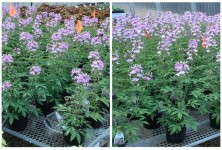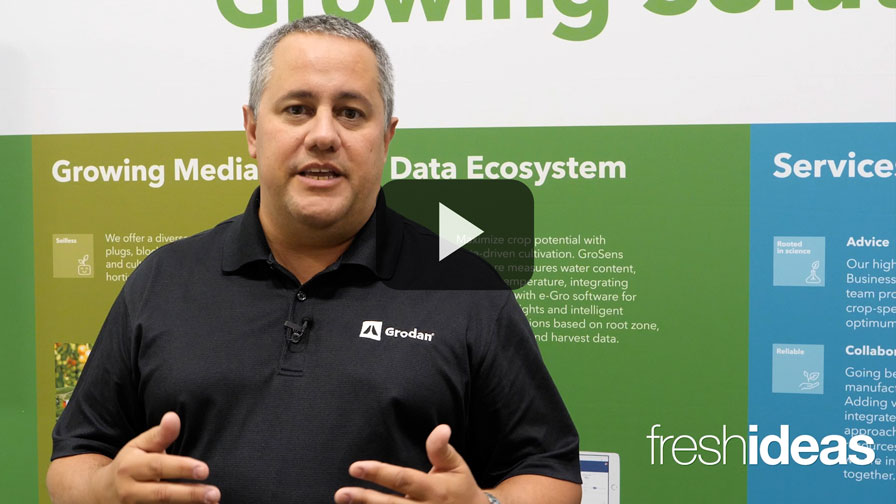Irrigating Crops On Demand

Automating greenhouse irrigation can be a huge labor saver, which is imperative for a modern greenhouse to be competitive. Irrigation controllers make it possible to automate greenhouse irrigation, but one usually programs the system to come on for a set time on a set schedule. Environmental conditions change such that a set program may be wrong more often than it is right. Sensing devices can be employed to aid a greenhouse operator making decisions about when to water, or one can take this a step further and let the substrate itself decide when it needs to be watered.
Comparing On-Demand To Automated Irrigation
Rather than have a set schedule programmed into a controller, it is possible to wire a moisture-sensing device, such as a tensiometer, between an electric valve and a source of electricity (transformer). When the moisture level in the substrate falls below a set-point, a switch on the tensiometer closes, allowing electricity to flow from the transformer to the electric valve, thereby irrigating the crop. As the substrate moisture increases, the tensiometer switch opens, stopping the flow of electricity, and the valve automatically closes.
Because the irrigation system is being turned on whenever the substrate reaches a certain set-point, we refer to this as on-demand irrigation rather than automated irrigation. If the crop calls for water three times in one day, the crop gets watered three times that day.
At Oklahoma State University, we have been using this system of on-demand irrigation to grow annuals and perennials for the department’s spring plant sale for the past three years. Students are responsible for checking the greenhouse daily, if not twice daily, but they have to do little to no hand-watering. The greenhouse is watered on-demand by a number of tensiometers wired between transformers and their associated electric valves. We feel we are able to grow higher-quality crops in a shorter period of time by using this on-demand system. To investigate it further, we conducted an experiment this spring comparing hand-watering to a tensiometer based, on-demand system of irrigation.
Comparing Hand-Watering To On-Demand Watering
Ipomoea ‘Margarita’ and Cleome ‘Seniorita Rosalita’ were chosen for the study. Two greenhouse benches of each were grown from plugs in the spring of 2013 in 6-inch plastic containers. All plants were grown in Metro-mix 902 (manufactured by Sun Gro Horticulture), to which was added 1.5 grams/liter of Everris Nursery Mix (19-3-10).
One bench of each species was watered by hand by our greenhouse manager and one bench of each was watered using drip irrigation controlled by a tensiometer, model MLT (manufactured by the Irrometer Company).
The tensiometer was placed in a sweet potato plant along the edge of the bench near the greenhouse heat source. In other words, the tensiometer was placed in the pot we assumed would dry out first and utilize the greatest amount of water. Both the sweet potato and cleome crops were controlled by one tensiometer. It was set to turn the water on when the substrate reached a moisture tension of 4.5 kPa.
The water was delivered by a drip system using Netafim polyethylene distribution tubing, into which was inserted a Netafim 2 gallon/hour emitter. The water from each emitter was split to eight pots for an effective rate of approximately 0.25 gallons per hour.
There were 80 plants per bench on the hand-watered benches and 79 plants per bench on the tensiometer controlled benches. Our greenhouse manager has more than 25 years of growing experience and we asked him to hand-water the crop as he saw fit. We wanted to compare hand-watering by an experienced grower using his experience and judgment to determine when the crop should be watered, to on-demand irrigation controlled by a tensiometer.
We kept track of how many times a day the crops were watered and estimated the volume of water used. Water from one drip emitter on each bench was collected and measured to estimate total water use for the tensiometer-controlled system.
For the plants that were hand-watered, the time it took to irrigate the crops at a known flow rate was recorded to estimate the total volume used by the hand-watering system. At the end of the study, we measured lateral growth on the sweet potato, and height and number of flower stalks on the cleome.
Crops Demanded More Water Than They Typically Get
The most surprising result of this study was how often the crops were watered. In a 20-day period, the hand-watered crops were irrigated nine times while the tensiometer called for water a total of 31 times, twice watering three times in one day (Figure 1). There were 11 days when the greenhouse manager chose not to water, while there was only one day when the tensiometer did not call for water.
Although the tensiometer-controlled crops were watered more than three times more frequently, the hand-watering method used approximately 10 percent more water than the on-demand system with drip. Hand-watering used approximately 168 gallons while the on-demand method used approximately 152 gallons during the 20 days of the study.
Cleome watered by hand grew to an average height of 16.6 inches while the cleome watered by the on-demand system had an average height of 22.9 inches. There were on average 2.6 flower stalks per plant on the hand-watered cleome and an average of 4.1 flower stalks on the on-demand cleome.
The length of sweet potato stems averaged 12.4 inches when hand-watered, while the on-demand sweet potato plants grew more than twice as much to an average of 30.5 inches.
On-Demand Irrigation Offers Taller, More Vigorous Plants
With on-demand irrigation controlled by a tensiometer and delivered by drip, we were able to grow taller cleome with more flowers and sweet potato vines with more than twice the growth than those watered by hand. We were able to do this using less water and saved a tremendous amount of labor by letting the tensiometer water the crops. Labor savings, greater growth, and less water use suggest that on-demand irrigation controlled by a tensiometer could have financial and environmental benefits for greenhouse growers.
With this study, it is not possible to tease apart the contribution by each of the variables but we speculate that the greater growth was caused by a more even moisture regime in the on-demand irrigation system. There was almost no leachate from the on-demand system suggesting that the pots were irrigated to less than field capacity, perhaps maintaining a higher level of oxygen in the root zone, and the crop was watered whenever the moisture tension reached 4.5 kPa.
With hand-watering, the pots were filled to field capacity and were allowed to dry down between waterings. It would be interesting to know how dry the substrate got between waterings in comparison to the 4.5 kPa.
Tensiometers Are Valuable Tools For Controlled And On-Demand Irrigation
Even if a grower wanted to maintain more control over their irrigation timing than using the simple on-demand system outlined here, a tensiometer can be a valuable tool for measuring substrate moisture. It is not affected by fertilizer or salt buildup in the substrate. It can be used as a monitoring device to decide when to water and it can be used in conjunction with an irrigation controller, allowing the crop to be watered when the substrate is dry but preventing irrigation when the substrate is moist.
If the tensiometer is wired between the controller and the valve on the common wire, it can act as a common wire interrupt preventing the valve from turning on even though the controller is scheduled to water. An irrigation controller can be programmed to water three times a day but the crop will only be watered if it actually needs it.
If using a tensiometer as part of an irrigation system, there are certain precautions that should be taken. First of all, the crop must still be monitored. Although we believe the tensiometer is better at making watering decisions than perhaps even the most experienced grower, it is not a substitute for good oversight of the crop.
Like any automated system, problems can arise. For example, with the on-demand system outlined here, if the tensiometer or the drip tube were to fall out of the pot, there would be no way for the tensiometer to read the substrate moisture level and the irrigation would remain on until manually turned off or until the problem were fixed.
We have found the tensiometer to be a very valuable greenhouse tool that has saved tremendous amounts of labor, allowed us to cut back our crop time and helped us grow better crops.
We zone our greenhouse so that crops of similar age, pot size and water use requirements are controlled by their own tensiometer but we were pleasantly surprised by how many different crops we were able to manage on the same zone. We place the tensiometer in the crop that we think will require the most amount of water and make sure to use a well-draining greenhouse mix, so even if other crops are being watered more than they need, the substrate drains quickly. GG








